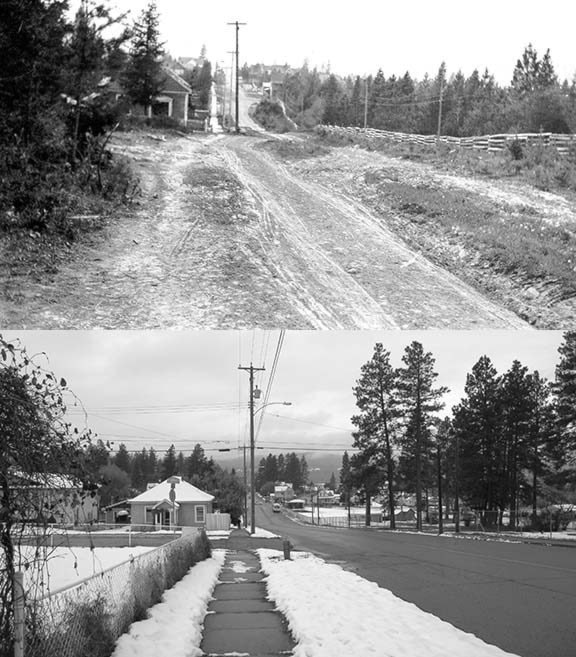Jim Cameron
Once upon a real time in the little town of Cranbrook there were two big problems regarding the construction of roads.
Problem one: laying roads through the tree and brush-infested, rock-covered, marsh-laden, clay-hardened soil upon which the town rested.
Problem two: finding money to fund the enterprise.
In theory, funding was to come from taxes paid by the townspeople to the provincial government, although the townsfolk complained regularly that the provincial rewards were few and far between. Local shopkeepers and hotelmen may have been willing to cough up the cash to have a road and a sidewalk placed in front of their business but they were certainly not prepared to take care of residential streets and alleyways.
Sidewalks, or the lack of them, also created problems. Generally speaking, each business would construct its own front wooden sidewalk, varying in technique from good to barely passable and thus, within a year or so of inception, the downtown district was generally taken care of sidewalk-wise.
The residential quarters, however, were left to fare as best they could. The issue might be solved through the financial subscription of the residents themselves, as in the case of the first sidewalk to Baker Hill in January, 1900. The only problem with that particular system was the payment of monies promised, as in the case of the first road to Baker Hill in January, 1900.
In all fairness, the amount owing on the $288 bill was only $18.20, admittedly a small sum for the good people with the large houses but, nonetheless, not entirely satisfactory to those concerned.
The general flurry of sidewalk construction in 1899-1900, gave way to complaints of sidewalks in poor repair by 1904, and a general outcry arose calling upon the government to maintain the public byways. The outcry appears to have landed upon deaf ears.
Cranbrook, now incorporated as a city, took matters into its own hands in 1906 by passing Bylaw #23 to raise $10,000 through debentures for street grading, road construction and the building of sidewalks.
There was some local unrest when the first sidewalk on Baker Street was laid on the corner of Van Horne Street directly in front of the store owned by Mayor Rogers but, it was pointed out, sidewalks need to start somewhere and it seemed like a logical spot, which indeed it was, the positioning of the mayor's store nothing more than mere coincidence.
As the sidewalks arose, the walking public rejoiced — mothers in long skirts pushing baby carriages being among the most grateful. Roads previously denounced by townspeople and tourists alike became scenes of intense labour, with many stumps and trees and rocks removed, hills reduced, surfaces graded and bridges improved. The mud and dust and ruts soon reappeared but it was newly minted mud and dust and ruts and people were happy for a period of about a very short while.
Then matter of maintenance reared its rather large head. So saying, the city fathers passed Bylaw #48 in May, 1908, which required every adult male (with some exceptions) carrying on business or residing within city limits to be entered on a "Road Tax Roll" and to pay a sum of $2.00 each year for road care.
Needless to say, the bylaw did not meet with complete approval. Perhaps the biggest argument was the fact that those paying the tax were now allowed to vote in municipal elections. It was thought by some (primarily those already eligible to vote) that the influx of new and possibly undesirable voters could create problems. Further, it failed to consider the women of the town. This wasn't necessarily a problem at the time. In fact, many women held property and were thus already allowed to vote, but the issue would rise up in a big way following the First World War.
Thus, the city managed to create a future boondoggle involving roads, taxes, voting rights and women's emancipation in one fell swoop. That, however, is an issue for another day.
In 1909, the city purchased a water wagon and a half-ton road roller which did much to improve general travel. Streets were graded and even occasionally graveled or sanded. That same year new-fangled concrete sidewalks made their appearance on the first block of 9th and 10th Avenues.
In 1911, the city expended a sum of $3,500 on streets, sidewalks and the many bridges throughout the city and for the next few years travelers moved trippingly about town with nary a complaint, save for the occasional sidewalk board ripping the hem of pants and dresses, nails in boots, slivers in bare feet, twisted ankles from uneven or missing slats and numerous broken plate glass windows from flying rocks caused by speeding automobiles. With the latter in mind, the local Board of Trade lobbied city council to oil the roads. They lobbied from 1921 to 1923, at which point the city finally agreed and the oiling began.
Within two years the wooden sidewalks were (mostly) replaced with concrete and the city considered the paving of streets in the downtown core. In June ,1927, 9th and 10th Avenues once again took centre stage (joined shortly after by numerous others) as concrete was laid in the roadways. The twenty-four foot paving left a parking lane of eleven feet on each side at a cost to property owners of $55 per lot. Following a period of thirty days to allow the cement to cure, the city of Cranbrook sighed happily and threw open the roads of the future. No mud, no dust, no rocks, no stumps, just yard after yard of sweet, smooth concrete.
And everyone lived happily ever after. The End.
